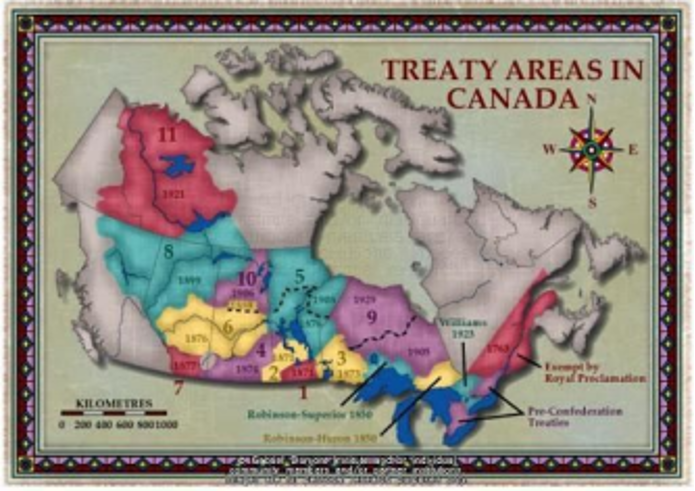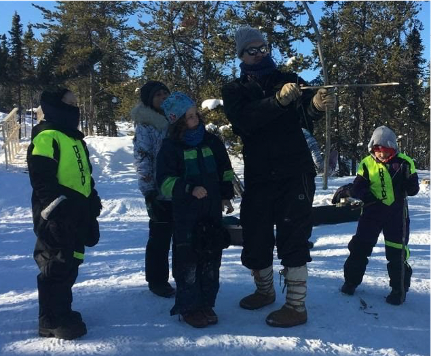Learning Story – Sharing Our Treaty History
What Happened?
This week during our opening circle we had a discussion about the history of treaty-making in Canada between Indigenous peoples and the Crown/government of Canada. We examined a map showing the numbered treaties and when they were signed. We focused on the different understandings of what the treaty agreements meant, including differences between what was discussed in-person (the oral agreements) and the written versions that the Crown representatives instructed the Indigenous leaders to sign.

Several of the Indigenous knowledge holders present, who are from various regions of the NWT, shared the understanding that has been passed down to them about treaties, and their personal experiences, including getting the $5 treaty payment each year (“a crisp brand-new dollar bill!”).
The kids were surprised to learn that Treaty 11 (covering much of the NWT) was signed only 100 years ago, and that the annual payment is still only $5. Some kids wondered if the treaties were a “scheme”, like a trick.

Following opening circle, the Bushkids had lots of fun playing Dene hand games, assisted by “drumming” with sticks on lids and benches. Then some challenged each other to leg wrestling matches. Several kids also chose to make their own bows and arrows, with advice and instruction from knowledge holders on the best kind of willow branches to use and safe whittling techniques.
Why is this meaningful?
It seemed like some of the children already knew these games. They may have played them at school or at home. There were a few children who seemed a little bit more competitive than others. Some of the kids wanted to keep trying until they won. The games we played can be considered competitive play because each team tried hard to win. These games are also an example of cooperative play and physical play because the children worked together and were active at the same time.
Opportunities and Possibilities

At Bushkids, one of our core principles is to create an “ethical space” where lots of space is made for Indigenous participants and knowledge holders to share their knowledge, stories and traditions, because the dominant educational structure is typically euro-western. This is particularly important as we work together to develop a fuller understanding of the treaties, the different ways they were interpreted historically, and how we can all move forward as treaty people, including our responsibilities today.
Within our diverse group of Bushkids participants and knowledge holders, we may relate to treaties in quite different ways. In addition to those whose ancestors may have been represented by treaty signatories (either Indigenous or British), there are Inuit and Métis participants who did not have the opportunity or chose not to sign treaties, and those from more recent immigrant or refugee families, some from countries that were themselves colonized by the Europeans.
What does this mean for the next session?
The theme of treaties leads to many important discussions that we hope to work through over time with the Bushkids. We must consider what it means for all of us to be treaty people – what responsibilities must be upheld by Canadians in order to honour the treaties. We will also discuss the “modern” treaties that have been signed more recently in the NWT and Nunavut, and those still being negotiated.
Residential schools were mentioned by several of the children and Indigenous knowledge holders during the discussion about treaties. We will consider how to further address this topic sensitively and appropriately. Several kids offered to bring books from home that have helped them to understand these themes.
